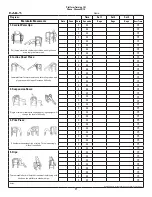
6
When performing “gait training” like “Step Ups” participants often use a walker placed over a step, which can
cause the participant to lean forward when they are on the step, which creates a fall risk. Participants are often
placed between parallel bars over a step which limits the person’s ability to train based on their ability to get to
wherever the parallel bars are stationed at the facility. Both are less than ideal solutions for safety and maximum
participation. Some residents won’t or can’t go to the location where the parallel bars are located in the building.
When performing “Step Ups”, on a Platform Trainer the participant will stand tall without having to lean over to
keep their grip on the 40” tall padded handrails. They will also be able to progress from doing a “Step Up” or doing
a “High Knee Raise” (2 separate moves) to combining those movements to (1 compound movement). This is done
by having the participant hold on to the handrails while stepping up on to the platform and then raising the trail leg
to a high knee position.
This progression would normally require multiple pieces of equipment and take up more space than just a single
Platform Trainer.
Point Out the Below Features When Introducing New Students/Clients to F.A.S.T.:
1. The handrails have padded grips, three training zones, and six keyhole elevations on the inside of each rail
that provides a place to lock in the Plyometric-Platform. There are two keyhole elevations on the outside of the
rails, where the Plyometric-Platform can be stored or units can be linked together.
2. The Plyometric-Platform has a padded top surface, four pegs protruding from each corner, and four spinning
casters underneath. It can be used on the floor for abdominal training, as a scooter, or it can be inserted and
locked into the handrails as a step, a slant board, a bench, a plyo box, or used to connect two separate units.
3. The frame and adjustable outriggers support the unit and give it stability.
4. The bar is stored on the frame and can be inserted and locked into the handrails in the same fashion as the
Plyometric-Platform. It can also be used to aid in stretching, as well as massage muscles when used with the
accompanying foam rollers.
5. The side panel pockets serve two purposes. First as a placard for movement instructions. Second as a place
to store the foam rollers, water bottles, and other fitness or assessment accessories.
Then Proceed STEP by STEP:
1. Begin with a
FIT TEST evaluation
(form included) using the movement chart that is printed on the inside
panels of the unit. Help the client/student determine which Training Zone elevation the platform or bar will
be locked in during each movement by experimenting with each move. Starting with movement one (1) under
Health, have the client perform each movement from left to right, then go to the next number until all 10
movements at all 3 levels have been considered. Evaluate their strength, endurance, stability, cadence, and
form to determine which of the 3 examples provided could be performed successfully and safely for 30 seconds.
2. Introduce the
Training Tracker
(form included). Record the date, the zone, the number of reps, time active, and
rest time between sets. Use the Notes section to remind the user of modifications or additional instructions.
Содержание F.A.S.T.
Страница 27: ......






































